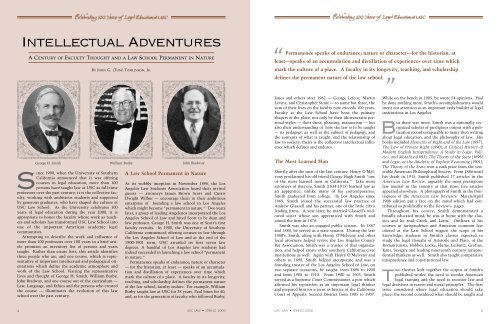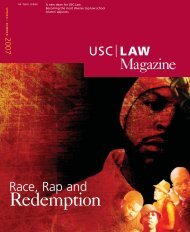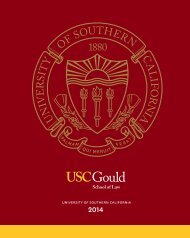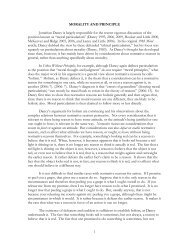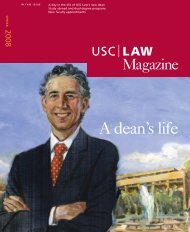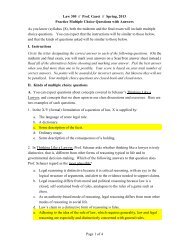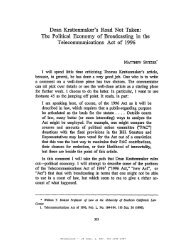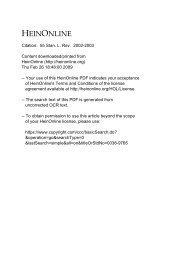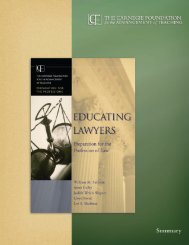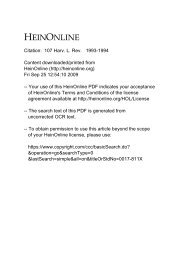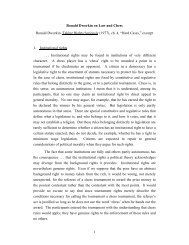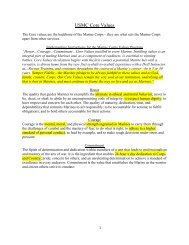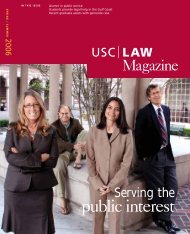Dean Scott H. Bice - USC Gould School of Law - University of ...
Dean Scott H. Bice - USC Gould School of Law - University of ...
Dean Scott H. Bice - USC Gould School of Law - University of ...
You also want an ePaper? Increase the reach of your titles
YUMPU automatically turns print PDFs into web optimized ePapers that Google loves.
Intellectual AdventuresA CENTURY OF FACULTY THOUGHT AND A LAW SCHOOL PERMANENT IN NATUREBY JOHN G. (TOM) TOMLINSON, JR.“Permanence speaks <strong>of</strong> endurance; nature or character—for the historian, atleast—speaks <strong>of</strong> an accumulation and distillation <strong>of</strong> experiences over time whichmark the culture <strong>of</strong> a place. A faculty in its longevity, teaching, and scholarshipdefines the permanent nature <strong>of</strong> the law school.“Since 1900, when the <strong>University</strong> <strong>of</strong> SouthernCalifornia announced that it was <strong>of</strong>feringcourses in legal education, more than 100persons have taught law at <strong>USC</strong> as full-timepr<strong>of</strong>essors over the past century; it is the collective faculty,working with ambitious students and supportedby generous graduates, who have shaped the culture <strong>of</strong><strong>USC</strong> <strong>Law</strong> <strong>School</strong>. As the <strong>University</strong> celebrates 100years <strong>of</strong> legal education during the year 2000, it isappropriate to honor the faculty whose work as teachersand scholars has transformed <strong>USC</strong> <strong>Law</strong> <strong>School</strong> intoone <strong>of</strong> the important American academic legalcommunities.Attempting to describe the work and influence <strong>of</strong>more than 100 pr<strong>of</strong>essors over 100 years in a brief articlepromises an inventory list <strong>of</strong> persons and yearstaught. Rather than create lists, this article identifiesthree people who are, and one course, which is representative<strong>of</strong> important intellectual and pedagogical orientationswhich define the academic atmosphere andwork <strong>of</strong> the <strong>Law</strong> <strong>School</strong>. Visiting the representativelives and thought <strong>of</strong> George H. Smith, William Burby,John Bradway, and one course out <strong>of</strong> the curriculum —<strong>Law</strong>, Language, and Ethics and the persons who createdthe course — illuminates the evolution <strong>of</strong> this lawschool over the past century.George H. Smith William Burby John BradwayA <strong>Law</strong> <strong>School</strong> Permanent in NatureAt its wobbly inception in November 1896, the LosAngeles <strong>Law</strong> Students Association heard their invitedguests — attorneys James Brown <strong>Scott</strong> and CurtisDwight Wilbur — encourage them in their ambitiousenterprise <strong>of</strong> founding a law school in Los Angeleswhich might become “permanent in nature.” Two yearslater, a group <strong>of</strong> leading Angelenos incorporated the LosAngeles <strong>School</strong> <strong>of</strong> <strong>Law</strong> and hired <strong>Scott</strong> to be dean andlaw pr<strong>of</strong>essor. George H. Smith was one <strong>of</strong> <strong>Scott</strong>’s firstfaculty recruits. In 1900, the <strong>University</strong> <strong>of</strong> SouthernCalifornia commenced <strong>of</strong>fering courses in law throughthe Los Angeles <strong>School</strong> <strong>of</strong> <strong>Law</strong> and at the end <strong>of</strong> the1900-1901 term, <strong>USC</strong> awarded its first seven lawdegrees. A handful <strong>of</strong> Los Angeles law students hadindeed succeeded in launching a law school “permanentin nature.”Permanence speaks <strong>of</strong> endurance; nature or character— for the historian, at least — speaks <strong>of</strong> an accumulationand distillation <strong>of</strong> experiences over time whichmark the culture <strong>of</strong> a place. A faculty in its longevity,teaching, and scholarship defines the permanent nature<strong>of</strong> the law school; faculty endure. For example, WilliamBurby taught law at <strong>USC</strong> for 38 years, Paul Jones for 40;and, as for the generation <strong>of</strong> faculty who followed Burby,Jones and others after 1962 — George Lefcoe, MartinLevine, and Christopher Stone — to name but three, thesum <strong>of</strong> their lives on the faculty now exceeds 100 years.Faculty at the <strong>Law</strong> <strong>School</strong> have been the primaryshapers <strong>of</strong> the place, not only by their idiosyncratic personalstyles — their dress, phrasing, mannerism — butalso their understanding <strong>of</strong> how the law is to be taught— its pedagogy, as well as the subject <strong>of</strong> pedagogy, andthe contents <strong>of</strong> what is taught, and the relationship <strong>of</strong>law to society; theirs is the collective intellectual influencewhich defines and endures.The Most Learned ManShortly after the turn <strong>of</strong> the last century, Henry O’Melvenyproclaimed his old friend George Hugh Smith “one<strong>of</strong> the most learned men in California.” Like mostattorneys <strong>of</strong> that era, Smith (1834-1915) learned law asan apprentice; unlike many <strong>of</strong> his contemporaries,Smith graduated from college. In Los Angeles since1869, Smith joined the successful law practice <strong>of</strong>Andrew Glassell and his partner, one <strong>of</strong> the little city’sleading firms. A year later, he married Glassell’s widowedsister whose son apprenticed with Smith andjoined the firm in 1878.Smith was also an engaged public citizen. In 1887and 1888, he served as a state senator. During the late1880’s, Smith, along with Henry O’Melveny and otherlocal attorneys helped revive the Los Angeles CountyBar Association; Smith was a trustee <strong>of</strong> that organization,and helped create other southern California civicinstitutions as well. Again with Henry O’Melveny andothers in 1898, Smith helped incorporate and was afounding trustee <strong>of</strong> the Los Angeles <strong>School</strong> <strong>of</strong> <strong>Law</strong>; ontwo separate occasions, he taught: from 1898 to 1900and from 1908 to 1910. From 1900 to 1905, Smithserved as a Supreme Court Commissioner, a post whichaffirmed his reputation as an important legal thinkerand prepared him for a term as Justice <strong>of</strong> the CaliforniaCourt <strong>of</strong> Appeals, Second District from 1905 to 1907.While on the bench in 1905, he wrote 54 opinions. Hadhe done nothing more, Smith’s accomplishments wouldmerit our attention as an important early builder <strong>of</strong> legalinstitutions in Los Angeles.But there was more. Smith was a nationally recognizedscholar <strong>of</strong> prodigious output with a publicationrecord comparable to many then writingabout legal education, and the philosophy <strong>of</strong> law. Hisbooks included Elements <strong>of</strong> Right and <strong>of</strong> the <strong>Law</strong> (1887),The <strong>Law</strong> <strong>of</strong> Private Right (1890), A Critical History <strong>of</strong>Modern English Jurisprudence: A Study in Logic, Politics,and Morality (1893), The Theory <strong>of</strong> the State (1895)and Logic, or the Analytic <strong>of</strong> Explicit Reasoning (1901);The Theory <strong>of</strong> the State won a cash prize from the venerableAmerican Philosophical Society. From 1886 untilhis death in 1915, Smith published 17 articles in theAmerican <strong>Law</strong> Review, arguably the most prestigiouslaw journal in the country at that time; five articlesappeared elsewhere. A photograph <strong>of</strong> Smith in the frontispiece<strong>of</strong> the American <strong>Law</strong> Review’s March/April1908 edition put a face on the mind which had contributedso prolifically to the Review’s pages.Throughout his oeuvre, Smith demonstrated abroadly educated mind; he was at home with the classicsand he read Greek and Latin. Outlines <strong>of</strong> hiscourses in jurisprudence and American common law<strong>of</strong>fered at the <strong>Law</strong> <strong>School</strong> suggest the scope <strong>of</strong> hisknowledge; students in Smith’s classes expected tostudy the legal thought <strong>of</strong> Aristotle and Plato, <strong>of</strong> theRoman jurists, Hobbes, Locke, Hume, Leibnitz, Grotius,Kant, Savigny and leading nineteenth century jurisprudentialthinkers as well. Smith also taught comparativejurisprudence and constitutional law.Two themes knit together the corpus <strong>of</strong> Smith’spublished works: the need to reorder Americanlegal training and the need to recenter law andlegal decisions in reason and moral principles. The firstissue considered where legal education should takeplace; the second considered what should be taught and4 <strong>USC</strong> LAW • SPRING 2000 <strong>USC</strong> LAW • SPRING 20005


